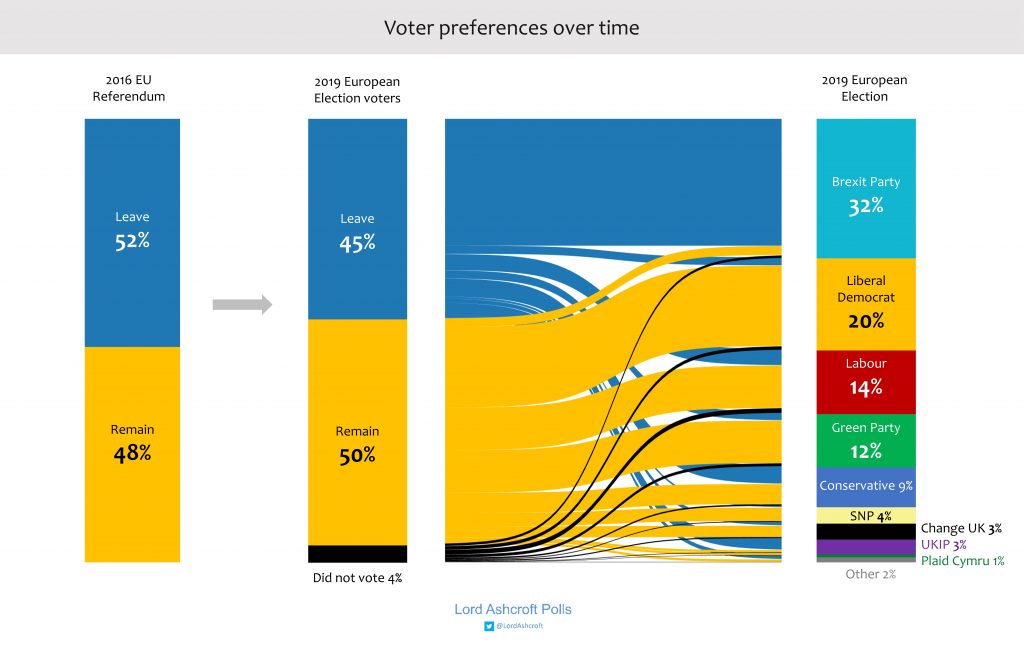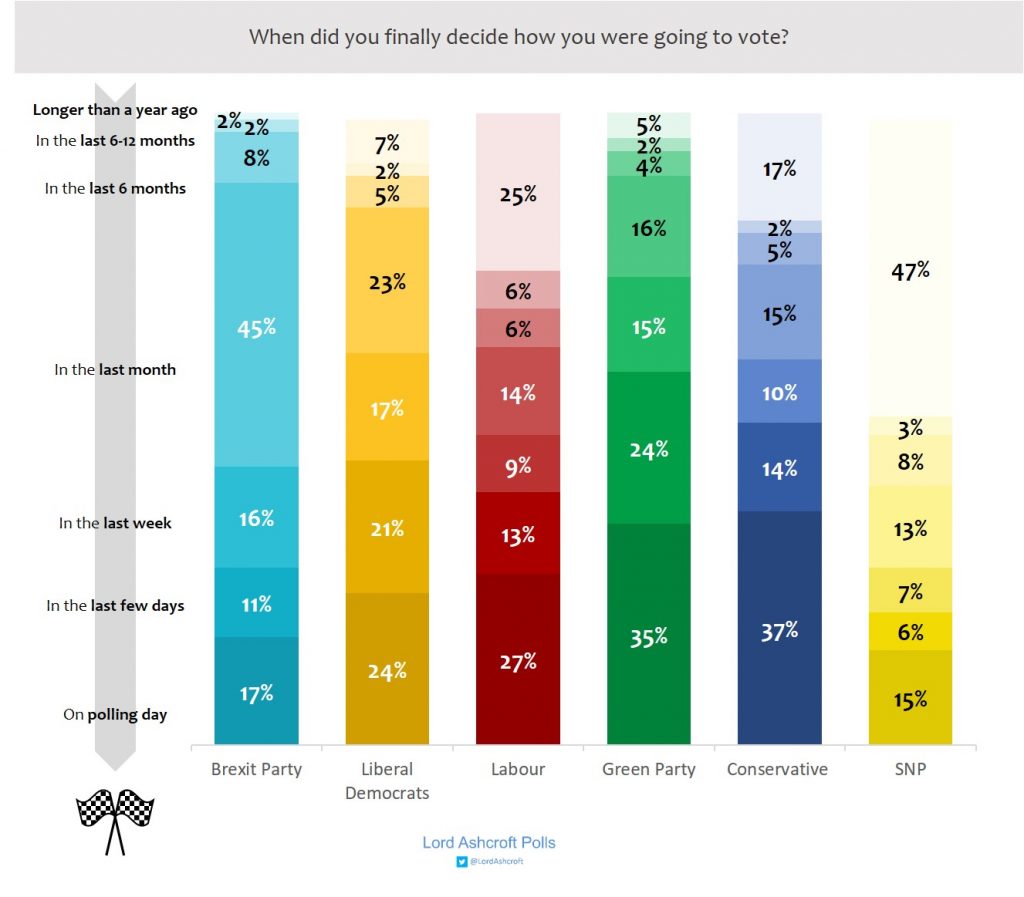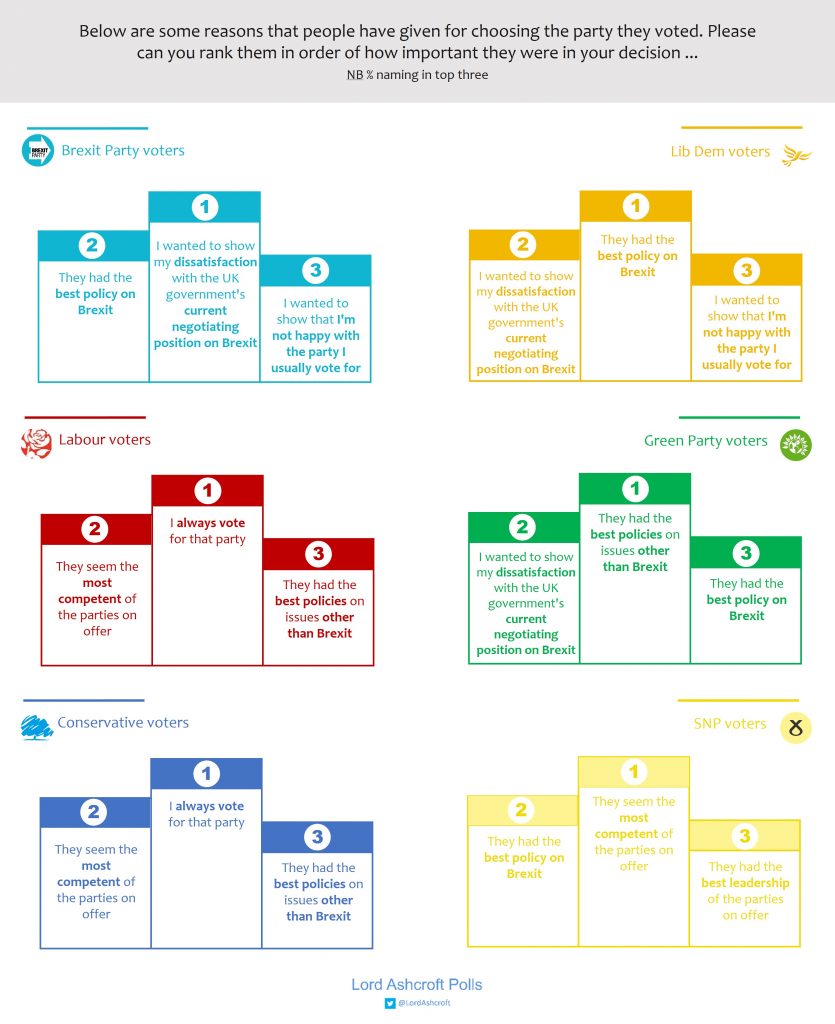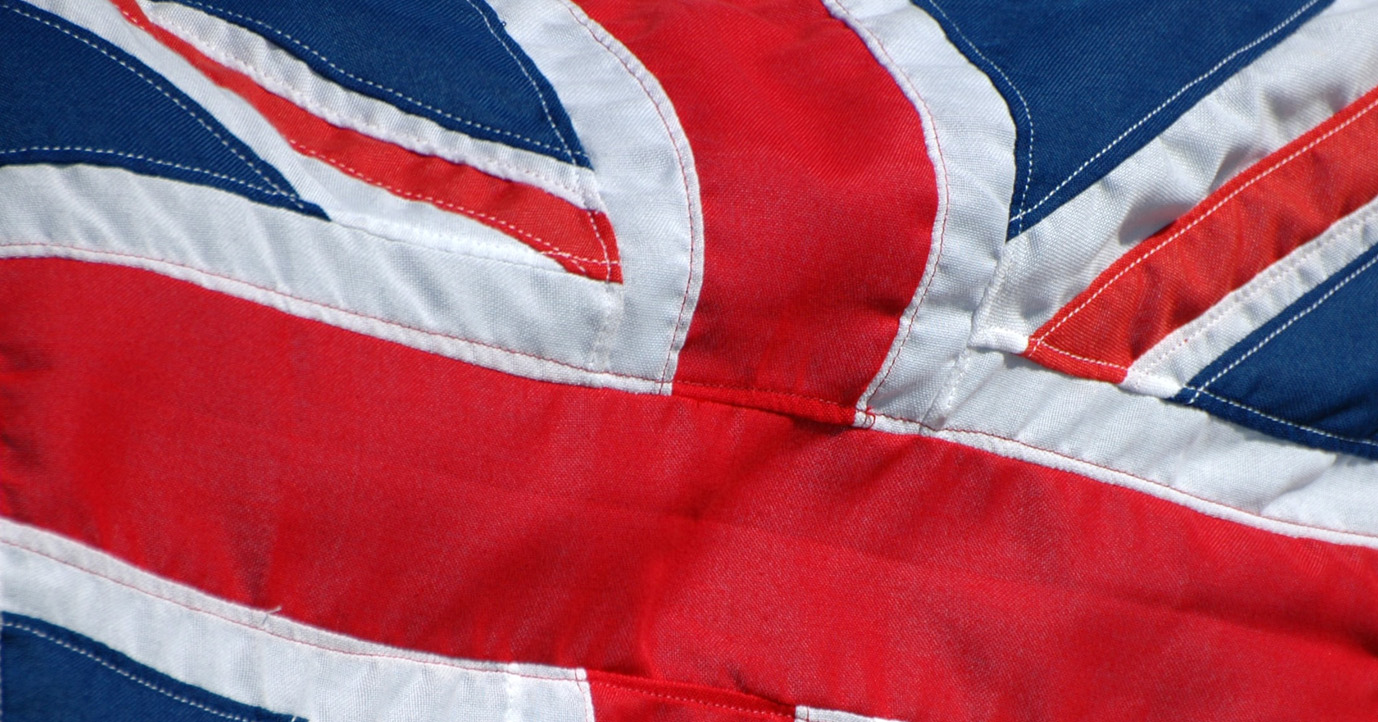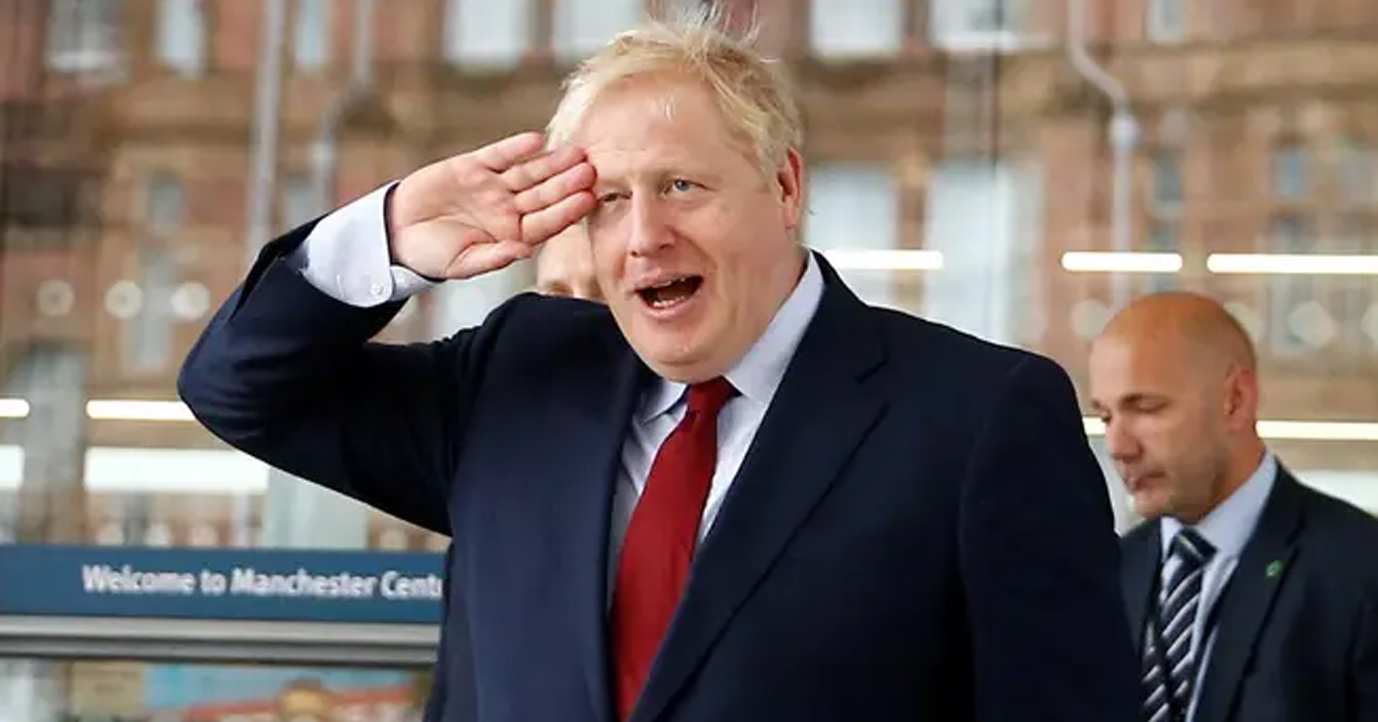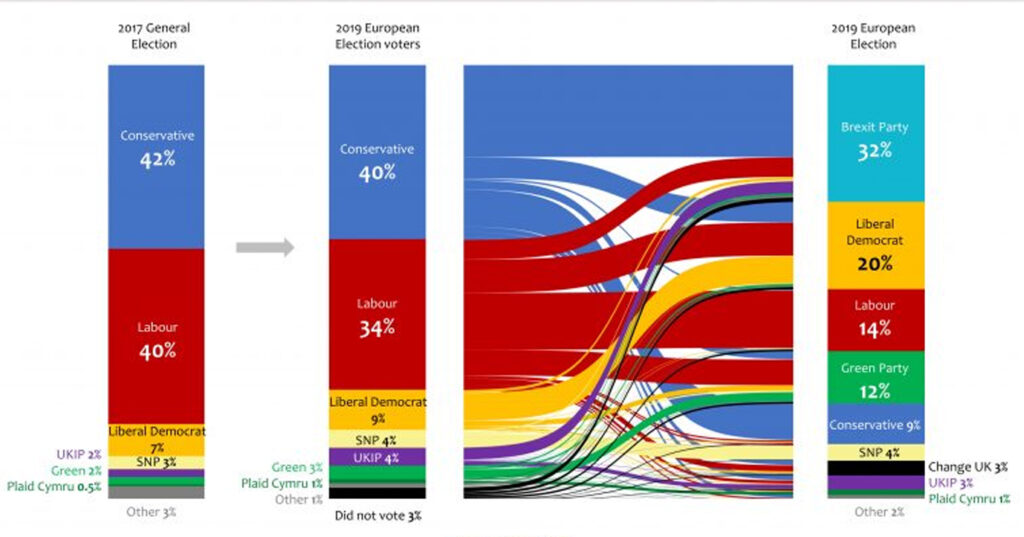
Since polling opened in the European elections I have surveyed over 10,000 voters to ask how they voted, why they chose the party they did, and – at least as of this weekend – what they see themselves doing at the next general election.
Who voted for whom?
More than half (53%) of 2017 Conservative voters who took part in the European elections voted for the Brexit Party. Only just over one in five (21%) stayed with the Tories. Around one in eight (12%) switched to the Liberal Democrats. Labour voters from 2017 were more likely to stay with their party, but only a minority (38%) did so. More than one in five (22%) went to the Lib Dems, 17% switched to the Greens, and 13% went to the Brexit Party.
For all the success of the Lib Dems in these elections, only 69% of their 2017 voters stuck with them: 13% switched to the Green Party and 7% backed the Brexit Party. Nearly seven in ten 2017 UKIP voters (68%) switched to the Brexit Party, with just under a quarter (24%) staying put.
To look at the question from the other end of the telescope, two thirds (67%) of the Brexit Party’s vote came from 2017 Tories, 14% from 2017 Labour voters and one in ten from former UKIP voters. The biggest single chunk of Lib Dem support in the European elections came from 2017 Labour voters (37%), with 31% coming from previous Lib Dems and 24% coming from 2017 Conservatives.
Overall, nearly two thirds (64%) of 2016 Leave voters backed the Brexit Party, with 9% voting Tory and 8% Labour. The Remain vote was split more evenly, with 36% going to the Lib Dems and 19% each going to Labour and the Greens. The Conservatives also received 9% of the Remain vote.
When did they decide?
Nearly half (45%) of Brexit Party voters said they had decided how to vote within the last month, with only 17% saying they decided on the day. Those who voted Conservative were more likely to say they did not make up their minds until polling day (37%). Labour voters were the most likely to say their voting decision had not been in question since the campaign got underway.
Why did they choose as they did?
Not at all surprisingly, three quarters (76%) of Brexit Party voters said having the best policy on Brexit was one of the top three reasons they voted as they did – but even more (84%) said they wanted to show their dissatisfaction with the UK government’s current negotiating position. More than half – including 60% of those who switched to Nigel Farage’s party from the Tories – said they wanted to show they were not happy with the party they usually voted for.
Lib Dem voters named having the best policy on Brexit as the main reason for backing the party (76%), with more than half (58%) saying they wanted to show dissatisfaction with the government’s negotiating position and nearly four in ten (38%) expressing dissatisfaction with their usual party. Nearly as many (38%) said they seemed the most competent party on offer.
Those who stuck with Labour and the Tories were much less likely to do so for Brexit-related reasons. Fewer than one in three (28%) Conservatives said the party having the best policy on Brexit was one of their reasons for backing them; 60% said they always voted Tory, 54% said they seemed the most competent party on offer, and 37% said they had the best policy on issues other than Brexit. Those who stuck with Labour gave the same top three reasons.
What should happen about Brexit?
Two thirds (67%) of Brexit Party voters said the best outcome from the Brexit process would be for the UK to leave he EU without a deal. A further 23% wanted to leave with a deal different from the one negotiated by Theresa May. These proportions were almost identical among Brexit Party voters who had switched from the Conservatives. Among those who stayed with the Tories, 36% backed Theresa May’s deal, while 17% wanted a different deal and 14% wanted no deal; 28% said they wanted the UK to remain in the EU. Nine in ten of those who voted Lib Dem wanted to remain, while three in ten Labour voters want to leave – most of those (18%) with a deal different from Mrs. May’s.
So while Leavers and Remainers have gravitated to parties who are unambiguous about Brexit, those who have stuck with the main parties are also polarised: two thirds (67%) of Tory Euro-voters want to leave the EU, while nearly two thirds (63%) of Labour Euro-voters want to remain.
Overall, 89% of Euro-election voters who voted Leave still want Brexit to happen – 55% of them with no deal – and 7% now say they want to remain. Meanwhile, 81% of remainers who voted last week say they still want to remain, with 15% now saying the best outcome would be to leave. Among all those voting in the European elections, 50% said they had voted to remain in the referendum and 45% to leave; now, 50% said they wanted to leave, 46% said they wanted to remain, and 4% didn’t know.
And at the next general election…
Only one in three (32%) of 2017 Tories who switched to the Brexit Party said they would come home at the next general election; 52% currently say they will stay with the Brexit Party. Conservatives who switched to the Lib Dems say they are even more likely to stay put: 61% now say they will vote Lib Dem again at the general election, with only 22% saying they expect to return to the Tories. Overall, only 43% of 2017 Conservative voters who turned out in the European elections say they will vote Tory at the next general election.
Half of Labour-Brexit Party switchers said they expected to stay with their new party at the next general election, with only just a quarter saying they expect to go back to Labour. Just over half (51%) of Labour-Lib Dem switchers currently say they will stay with the Lib Dems. Just over half (56%) of 2017 Labour voters say they will back Jeremy Corbyn’s party for Westminster.

